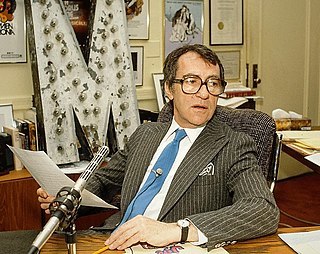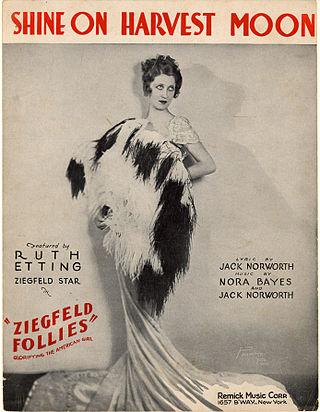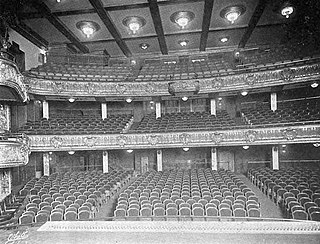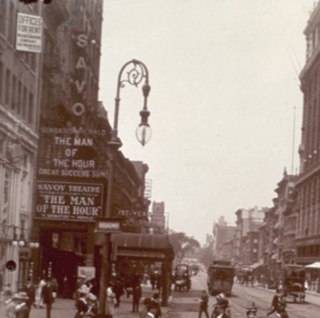
Joseph Papp was an American theatrical producer and director. He established The Public Theater in what had been the Astor Library Building in Lower Manhattan. There Papp created a year-round producing home to focus on new plays and musicals. Among numerous examples of these were the works of David Rabe, Ntozake Shange's For Colored Girls Who Have Considered Suicide When the Rainbow Is Enuf, Charles Gordone's No Place to Be Somebody, and Papp's production of Michael Bennett's Pulitzer Prize–winning musical A Chorus Line. Papp also founded Shakespeare in the Park, helped to develop other off-Broadway theatres and worked to preserve the historic Broadway Theatre District.

The Hayes Theater is a Broadway theater at 240 West 44th Street in the Theater District of Midtown Manhattan in New York City. Named for actress Helen Hayes, the venue is operated by Second Stage Theater. It is the smallest Broadway theater, with 597 seats across two levels. The theater was constructed in 1912 for impresario Winthrop Ames and designed by Ingalls & Hoffman in a neo-Georgian style. The original single-level, 299-seat configuration was modified in 1920, when Herbert J. Krapp added a balcony to expand the Little Theatre. The theater has served as a legitimate playhouse, a conference hall, and a broadcasting studio throughout its history.

Ziegfeld Girls were the actresses, singers, chorus girls, showgirls and other female performers who appeared in Florenz Ziegfeld's theatrical Broadway revue spectaculars known as the Ziegfeld Follies, produced in New York City. The revues were originally based on the Folies Bergère of Paris. Ziegfeld girls also included female performers who participated in the Ziegfeld Midnight Frolic and the Ziegfeld 9 O'Clock Revue (1919-1920).
Louis Ferdinand Gottschalk was an American composer and conductor born in St. Louis, Missouri. The son of a Missouri governor, also named Louis, he studied music in Stuttgart, Germany, where his father, a judge, was American consul. Louis Moreau Gottschalk was his great-uncle.

The Morosco Theatre was a Broadway theatre near Times Square in New York City from 1917 to 1982. It housed many notable productions and its demolition, along with four adjacent theaters, was controversial.
Barbara "Bobbie" Handman was an American political consultant and arts activist, known for her role in preserving historic Broadway theater houses. She was the executive vice-president and New York City office director of People for the American Way from 1981 until 2003.
Elisabeth Sanxay Holding (1889–1955) was an American novelist and short story writer. She primarily authored fiction in the hardboiled subgenre of detective novels.

Oliver Morosco was an American theatrical producer, director, writer, film producer, and theater owner. He owned the Morosco Photoplay Company. He brought many of his theater actors to the screen. Frank A. Garbutt was in charge of the film business. The company was merged with Adolph Zukor's Famous Players–Lasky Corporation in 1916.
Independent Theatre, formerly known as The Independent Theatre Ltd., was an Australian dramatic society founded in 1930 by Dame Doris Fitton in Sydney, Australia. It is also the name given to the building it occupied from 1939, now owned by Wenona School, in North Sydney, cited as Sydney's oldest live theatre venue.

Jessie Busley was an American actress and comedian who performed on stage, screen, and radio for over six decades.
Michael Davis is a comedic American juggler. He came to nationwide attention in the United States in the early 1980s, appearing on NBC's Saturday Night Live six times, the only professional juggler to perform on the show.

Douglas Wood was an American actor of stage and screen during the first six decades of the 20th century. During the course of his career, Wood appeared in dozens of Broadway productions, and well over 100 films. Towards the end of his career, he also made several guest appearances on television. Wood died in 1966.
Barry & Fran Weissler are Tony Award-winning, American theatrical producers.

George M. Cohan's Theatre was a Broadway theatre at Broadway and West 43rd Street in the Midtown Manhattan neighborhood of New York City. It was built in 1911 and demolished in 1938.

The Savoy Theatre was a Broadway theatre at 112 West 34th Street in Midtown Manhattan, New York City. It opened in 1900. It was converted to a cinema around 1910, until it was closed in early 1952 and then demolished.











